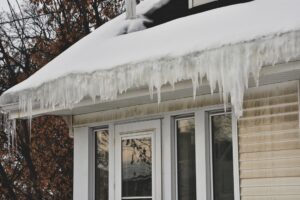
What type of underground drain do you have? Is the pipe made of black corrugated (ribbed) plastic or smooth PVC? Can you see the end of the pipe or is it buried? Is it designed to evacuate the water at the end of the pipe or percolate the water through holes along the pipe? Does it connect to a French drain or maybe a grated drain that goes across your sidewalk? Is it clogged? How can you tell?
Do Your Gutters Have Underground Drains?
Underground drains are essential for effective water management in residential areas, especially in places like Colorado’s front range.
If you have underground drains or are considering installing them, then this blog can help you with making that decision and assist with tips on keeping them clog-free from someone who is obsessed with proper water drainage.
First, let’s examine the pros and cons of underground drains on residential gutter systems in Colorado, as it is a double-edged sword.
Advantages and Maintenance of Underground Drains
Some of the advantages of having an underground drain are that the water flows underground and cuts down on puddling on the surface during heavy storms, which can cut down on the breeding of mosquitoes. It eliminates surface erosion. It can prevent safety hazards by routing the water under walkways instead of flowing on top of them and freezing when the temperature drops. They are also more aesthetically pleasing than the three feet of plastic tube you bought at Home Depot and slapped on the end of your downspout.
Disadvantages and Maintenance of Underground Drains
One disadvantage of having an underground drain is that it can be problematic. They clog easily and to clean them out you have to take apart the downspout to access the pipe, then you have to clean out the pipe with a hose or a snake. If you have an asphalt shingle roof it will constantly shed grit and gravel over 25lbs over ten years. Where does the grit and gravel go? It will build up in your gutters unless they are pitched correctly to flow to the downspout and if your downspout is connected to corrugated pipe you will eventually see a clog from all the grit build-up in the ribs. If the end of your pipe terminates underground and you can’t see the end, it can become clogged with roots and dirt.
Eventually, the water backs up the pipe and bubbles out where the downspout connects, usually one inch away from your foundation. Your underground drain pipe can also freeze and become clogged with ice. The ice can back up your downspout and into your gutters.
Once your gutters fill with ice the weight can cause the aluminum to contort, ungulate, and become backward-pitched. When the spring rains come your gutters will overflow like they are clogged because water cannot flow uphill. The ice inside your gutters and downspouts expands and contracts, pulling your brackets from the fascia and also splitting open the seam on the back of the downspout so the water from the spring rains will escape and damage the side of your home. Warping from ice build-up is the main cause for the structural failure of gutters in Colorado, that’s why the average life span of a standard open gutter in Colorado is between 10-15 years. They last much longer in other states that don’t have as extreme fluctuations in temperature (60 degrees at noon and negative 2 by 5 pm sometimes in January).
How deep under the ground is your pipe? The freeze line is between two to 3 feet in Colorado and many drain pipes are installed just below the surface at a depth of six inches.
How Can You Tell if Your Underground Drain is Clogged?
Some tell-tale signs are; “tumors” on your downspout where the aluminum has warped from the ice expansion along with the seam splitting on the back of the downspout. Other signs are water flowing over the top of your gutter, and water escaping where the bottom of the downspout and the underground drain meet.
Selecting the Right Drain Materials
If you are considering installing an underground drain we recommend using noncorrugated PVC for your pipe. The smooth inner surface prevents buildup in the ribs. If you have an existing underground pipe made of corrugated plastic that was installed in the 1990s or early 2000s, we would consider abandoning the pipe (if possible) and adding a three-foot tip-up extension instead. We prefer seeing the water come out of the end of the pipe versus the water disappearing underground because you know with certainty where the water is ending up.
What Can You Do To Prevent Clogs in Your Underground Drain?
Install the K-Guard clog-free gutter system on your home. We use a special underground drain adapter to correctly fit the downspout into the underground drain pipe so debris can’t work its way in on the sides. We also install a drain trap, which is a removable basin that catches all dirt, grit, and fine-sized debris that can work its way into our hooded system. The drain trap ensures that only pure water is flowing into your underground drain. We recommend cleaning them once every three to six months.
We can also install heat cable in your gutters, and downspouts, and in some cases extend the cable in your underground pipe up to three feet to prevent ice clogging. These are all things we consider while conducting an inspection and estimate on your home.
Call K-Guard today so we can send one of our professionals out to determine what the best and most cost-effective solution would be for your home.



